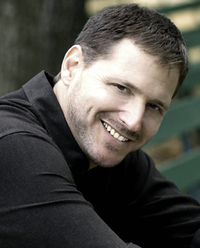Rick Mathieson
Website
Twitter
Genre
Rick Mathieson isn't a Goodreads Author
(yet),
but they
do have a blog,
so here are some recent posts imported from
their feed.
More books by Rick Mathieson…
“Culturally one of the most difficult things that happens is to get creative people to understand [that] the world is no longer just defined by television. The thing that happened, and has been happening for some time here, is that our work was much more diverse than even we knew it was. And I think as we began to change, the way we tackled problems and the way that we looked at problems was completely and utterly holistic in a way that I’d probably not ever really experienced before.”
― The On-Demand Brand: 10 Rules for Digital Marketing Success in an Anytime, Everywhere World
― The On-Demand Brand: 10 Rules for Digital Marketing Success in an Anytime, Everywhere World
“then I did something that probably had not ever been done before, because it hadn’t needed to be done before, which is to literally look at all the work that we had produced for all our clients. Not necessarily from the standpoint of what does the work look like and is it creative, but more about how much time does it take us to actually get to a piece of communication that we can sell to a client, and how many bits of television are we making, how many bits of Internet work are we creating. And I looked at it to a certain extent more like a factory, to work out whether we have the right machinery in place to make the factory work properly. As we went through, it changed almost at a level that would be staggering in our industry. We went from 17.5 percent of our work within new media to 50 percent in the first year. Now, our digital production department is as big as our broadcast production department. And our output is now 60/40 in favor of nontraditional interactive work. That’s a massive change. Not just in what we produce, but also, you’ve got to try and mirror that change with the resources you have. And you’ve either got to shed some resources and get some new resources in, or you’ve got to reskill people on the move. And that is a more complicated task, but that’s one of the things that we’ve managed to do very successfully.”
― The On-Demand Brand: 10 Rules for Digital Marketing Success in an Anytime, Everywhere World
― The On-Demand Brand: 10 Rules for Digital Marketing Success in an Anytime, Everywhere World
“For some time now, the conventional wisdom at most agencies has been to partner with experts in specific fields—social networking, gaming, mobile, or any other discipline—in order to “get the best people for the job.” But given the success of AKQA, R/GA, and so many other innovators, perhaps it can be argued that to be truly holistic in our approach, it’s better to grow innovations from one’s own stem cells, so to speak, than to try to graft on capabilities on an ad-hoc basis. Some would no doubt argue that it makes the most economic sense to hire experts to execute as needed, rather than taking on more overhead in an increasingly competitive marketplace. But it should be pointed out that it’s hard to have the original ideas themselves if your own team doesn’t have a firm grasp of the technologies. Without a cross-disciplinary team of in-house experts, who knows what opportunities you—and by extension, your clients—may miss. “It comes down to the brains that you have working with you to make it a reality,” John Butler, cofounder of Butler, Shine, Stern & Partners, tells me. “The history of the ad agency is the Bernbach model—the writer and art director sitting in a room together coming up with an idea,” he says, referring to legendary adman Bill Bernbach, cofounder of DDB and the man who first combined copywriters and art directors as two-person teams. Now, all that’s changed. “[Today, there are] fifteen people sitting in a room. Media is as much a part of the creative department as a writer or an art director. And we have account planners—we call them ‘connection planners’—in the room throwing around ideas,” he says. “That facilitates getting to work that is about the experience, about ways to compel consumers to interact with your brand in a way that they become like free media” by actively promoting the brand for you. If his team worked on the old Bernbach model, Butler adds, they would never have created something like those cool MINI billboards that display messages to drivers by name that I described in the last chapter. The idea actually spun out of a discussion about 3-D glasses for print ads. “Someone in the interactive group said, ‘We can probably do that same thing with [radio frequency identification] technology.’” By using transmitters built into the billboards, and building RFID chips into MINI key fobs, “when a person drives by, it will recognize him and it will spit out a message just for him.” He adds with considerable understatement: “Through having those capabilities, in-house engineers, technical guys who know the technology and what’s available, we were able to create something that was really pretty cool.”
― The On-Demand Brand: 10 Rules for Digital Marketing Success in an Anytime, Everywhere World
― The On-Demand Brand: 10 Rules for Digital Marketing Success in an Anytime, Everywhere World
Is this you? Let us know. If not, help out and invite Rick to Goodreads.









